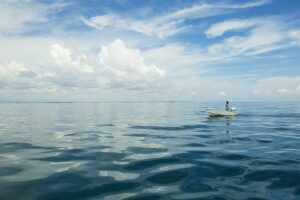
This turbine, which was awarded the Thomas A. Edison Patent Award by the American Society of Mechanical Engineers, is designed to harness the energy of moving water. No dams are necessary. It can generate electricity wherever water flows, from streams and canals to the open oceans where tidal currents contain huge amounts of energy. Gorlov estimates that the currents passing under the Golden Gate Bridge everyday could generate more than twice the city’s electricity needs, even at times of peak demand.
Norway has already installed a free-flow power grid in deep water off its coast where the currents are strong and constant. Companies in both the United Kingdom and the United States are working on their own versions of the turbine.
Gorlov’s design is unique in that the blades will rotate no matter what direction the current is flowing from. A slight helical twist to the blades also causes them to turn faster than the actual flow of the water hitting them. Despite widespread enthusiasm for the turbine, only a few small-scale pilot projects have been built in the United States.
However, South Korea presents another story. With extremely limited natural resources, but a fast-growing economy, the country is under heavy pressure to meet increasing energy demands. Fortunately, the Korean peninsula has a lot of fast-fl owing water. The first project in the Uldolmok Strait’off Korea’s western coast’was a huge success and a second phase is now under development. If the turbines continue to perform, the government plans to install enough turbines to equal the output of four nuclear power plants.
Concerns about the effect the turbines might have on fish have been alleviated as it appears that the turbines create a pressure that causes fish to swim away from the blades. Yet other concerns linger about the longevity of the turbines in harsh and possibly corrosive environments.
While new technology always comes with its share of uncertainties, entrepreneur Gorlov remains optimistic. He happily declares, ‘The Gulf Stream contains enough energy for all of North America.’
—On Earth Magazine


